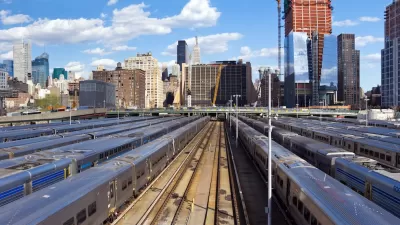Funding from a nonprofit initiative provides concrete measures to prevent displacement due to the construction of the Green Line in the Twin Cities.
Major infrastructure projects such as railway constructions often result in displacement of adjacent homes as well as negative impacts to surrounding businesses. As Jessica Leber reports, in building the Green Line light rail line to connect Minneapolis and St. Paul, everyone from the "government, nonprofits, businesses, and the local community" convened from the planning stage to avoid such outcomes.
Aptly named the Corridor of Opportunities project, the Twin Cities' collaborative effort was possible due to support from the nonprofit organization Living Cities and its Integration Initiative. Leber describes the goals of the initiative: "For the last three years, the initiative has provided a total of $85 million in grants, low-interest loans, and market-rate loans…To get everyone who has a stake in the city’s future working together to tackle a specific problem."
The Integration Initiative grants in conjunction with funding from the U.S. Department of Housing and Urban Development allowed the Corridor of Opportunities team to approach the transit-oriented project with the interest of the communities in mind: "[The team] created city staff jobs devoted to transit-oriented development and passed laws that changed the system, such as assigning greater weight to affordable housing projects located near transit" as well as "financing seven mixed-income and affordable housing development [sic]…about two dozen smaller projects and market research studies that would not only bolster the communities disrupted by construction and [sic] but also protect them from inevitably rising land values in the future." Other efforts included "fund[ing] facade and infrastructure improvements to help businesses improve their own look."
Leber notes the project's successful outcome: "Of 350 businesses that received assistance during the period of heavy construction, only four folded." Nine other cities are currently working with the Livable Cities' Integration Initiative.
FULL STORY: Linking Minneapolis And St. Paul With A Transit Project That Doesn't Destroy Communities

Planetizen Federal Action Tracker
A weekly monitor of how Trump’s orders and actions are impacting planners and planning in America.

Map: Where Senate Republicans Want to Sell Your Public Lands
For public land advocates, the Senate Republicans’ proposal to sell millions of acres of public land in the West is “the biggest fight of their careers.”

Restaurant Patios Were a Pandemic Win — Why Were They so Hard to Keep?
Social distancing requirements and changes in travel patterns prompted cities to pilot new uses for street and sidewalk space. Then it got complicated.

Platform Pilsner: Vancouver Transit Agency Releases... a Beer?
TransLink will receive a portion of every sale of the four-pack.

Toronto Weighs Cheaper Transit, Parking Hikes for Major Events
Special event rates would take effect during large festivals, sports games and concerts to ‘discourage driving, manage congestion and free up space for transit.”

Berlin to Consider Car-Free Zone Larger Than Manhattan
The area bound by the 22-mile Ringbahn would still allow 12 uses of a private automobile per year per person, and several other exemptions.
Urban Design for Planners 1: Software Tools
This six-course series explores essential urban design concepts using open source software and equips planners with the tools they need to participate fully in the urban design process.
Planning for Universal Design
Learn the tools for implementing Universal Design in planning regulations.
Heyer Gruel & Associates PA
JM Goldson LLC
Custer County Colorado
City of Camden Redevelopment Agency
City of Astoria
Transportation Research & Education Center (TREC) at Portland State University
Camden Redevelopment Agency
City of Claremont
Municipality of Princeton (NJ)





























